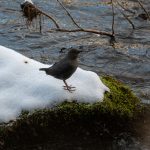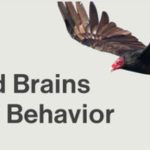David Ringer of Search and Serendipity pondered some deceptively slippery subtleties about the nature of seeing recently:
In that brief moment, a question I’ve long pondered became much less hypothetical: If I saw a bird in a mirror or reflected in a body of water would I feel satisfied enough to list it? In this case, there was no life bird at stake, and I couldn’t even identify the bird I saw…
…Somehow, my psychological sense of “seeing†is such that I feel I must be looking in the proper direction, even if my eyes can’t detect the bird on their own. Optics send the light directly into my eyes, and I can believe that they are an extension of my own powers of perception. I have no trouble believing that I’m looking at the bird directly.
The crux of the question as I understand it is whether compromised visual perception of a bird still counts as spotting it for birding, or at least listing purposes. My own response was that just like you can’t unring a bell, you can’t unsee a bird. If my life Crested Caracara only grazed my field of vision but I was able to identify it, either through my own or more likely someone else’s account, then I saw the bird. Maybe I didn’t see it as well as I’d have liked, but the object did make an optical impression. It makes my list, but I’ll keep angling for a better view.
I would guess that the experience of incomplete apperception is common among birders. Anyone who’s ever allowed a tour leader to differentiate an Empidonax flycatcher or distinguish a Savannah from a Song Sparrow and subsequently took the lifer knows what I’m talking about. I bet most birders do. Anyone who has spent any time birding an unfamiliar ecosystem like a rainforest under the auspices of an expert guide knows as well. Whether I could pick a Ruddy Woodcreeper or a Yucatan Vireo out of a lineup matters not a whit, not since someone who actually could identified these birds for me years ago. These species are both on my life list and won’t be coming off unless the ornithological oracles lump or split them beyond recognition.
My point is that most birders have a fairly flexible definition of “sighting” but only in conjunction with a strict observation of “identification.”
I brought David’s original observations on the subject here because I’m interested to hear what other people think about the nature of seeing. Also, consider some similarly sticky sighting scenarios. For example, I have issues when spotting the drabber member of a dimorphic pair. If you’ve only seen a female Summer Tanager, have you really seen one? Taxonomically, the answer is obviously yes, but can you be satisfied with this sighting? A number of birds on my list are there under protest as it were; the sighting won’t be solidified until I’ve met the more magnificent member of a species. Do you feel this way too or are you driven more by biology than beauty?













This illustrates one of the main problems that I have with listing, this need to create another tick in a book that has nothing to do with the bird or birds at all. Walking through a jungle in Ecuador with a guide calling out the names of birds, unseen or barely seen and everyone madly rushing to add species to their lists because, by gawd 327 is a better number than 317. I know it is “to each their own” but I don’t know having a guide pick out one bird and to help me see just why that particular bird is a Screaming Piha, seems much more satisfying.
And there is incredible beauty in a female Summer Tanager, why would it be worth any less on a list?
If I’ve seen the bird and identified it with or without help (and I only consider it id’ed with help if I can see the clinching mark[s] myself), it gets listed. The question about mirrors or reflections is metaphysical hair-splitting IMHO — I’ve never seen a bird under either circumstance that I could make a lifer out of.
And of course a female or drab winter male, juvenile, or whatever counts. Beauty is merely one of the inducements to birding, not the ultimate point. if you can’t see the beauty in the behavior, setting, or simple existence of a bird, you ought to just stay home.
For me, Clare, listing helps me make sense of both the scientific classification of avifauna and my own mad meandering to observe birds. Without some sort of list, I’d have a hard time keeping track of what I’ve seen. Plus, I kind of like the collectible nature of wildlife sightings!
However, I definitely agree with your point that taking the time to know each bird is essential.
Yes, there is incredible beauty in any bird, but I think we can all agree that, for each of us, some things are more beautiful than others. I’m attracted to color so I’m not knocking the less colorful representatives of a species, but simply saying that I don’t feel I’ve really seen a bird like, say, a Vermilion Flycatcher until I see it in all its scarlet glory. Of course the juvenile vermilion counts. I’m just looking forward to seeing every species at the height of its chromatic intensity. For example, I just observed my first Lapland Longspurs and, while their winter plumage has a subtle beauty, I probably haven’t seen it at its most visually impressive until I’ve seen it in breeding plumage as well.
Of course Mike, why wouldn’t one want to see a male Summer Tanager in all it’s glory, and I keep a list also. Its just where the list lies in priorities that I have trouble reconciling… and that is a personal preference of course, who am I to say that a love of checkmarks in a book is less valid than a love of birds in the field.